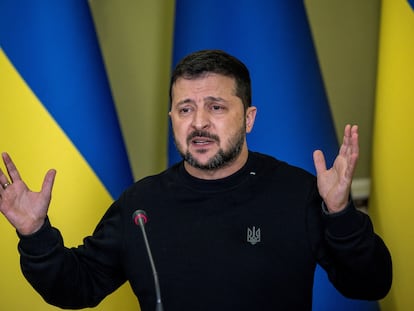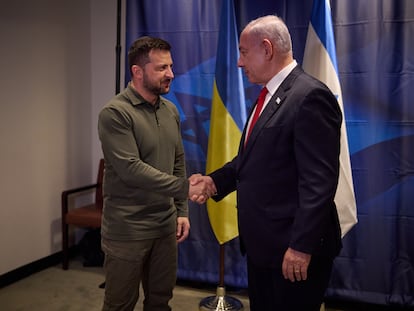In Russia-occupied Severodonetsk, destruction and exodus are visible everywhere: ‘The city was wonderful. Now, there is almost no life’
EL PAÍS has been traveling to the area controlled by Russian troops for more than a year. The few remaining inhabitants have tried to resume their lives, amidst the constant noise of artillery from the front
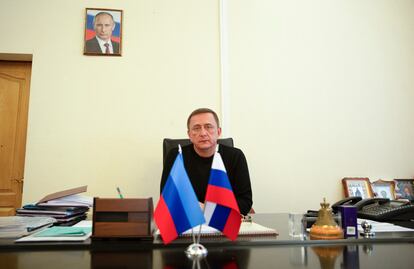

Behind the walls of the Lesnaya Dacha shrine are the graves of almost 400 people. All of them were civilians, killed in last year’s battle for the city of Severodonetsk, in the Ukrainian province of Luhansk. The silence surrounding the forest of graves is broken by the roar of the constant explosions that come from behind the hill, where the neighboring city of Lysychansk stands. It borders the now-stangant front.
In the cemetery, none of the wreaths of flowers bear the colors of the Russian flag, unlike in other graveyards along the border with the Russian province of Belgorod. There, some red, white and blue bouquets say goodbye to friends and family, who served in the offensive against Ukraine.
Most of the Luhansk region was seized from Ukraine in the Donbas War of 2014 and 2015. However, on paper, its formal annexation by Russia last year isn’t recognized even by the Kremlin’s partners (except for Syria and North Korea). Russian allies such as China and India, for instance, demand that Ukraine’s territorial integrity be restored.
The destruction appears suddenly, shortly before reaching the demarcation with the next Ukrainian province: Kharkiv. There, after the lush forests, there’s a field blackened by ashes and thousands of trunks, which were uprooted during the battle in February 2022.
A succession of destroyed houses and factories leads the way to Severodonetsk, where not a soul is seen in the streets, which have been reduced to rubble. “The city was wonderful. Now, there’s practically no life. Only the elderly and the disabled [remain],” laments Andrei, a 64-year-old man, who lost a leg during the fighting for Severodonetsk from March to June of last year. “I lent a hand during the bombings, I carried bread and medicine by bicycle. I was wounded and the Russians took me to Luhansk (the city), where they amputated my leg,” he explains, at his small stall in the central market, where he sells electronic cigarettes.
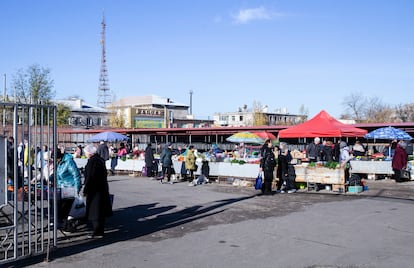
Several members of Andrei’s family — including his granddaughter — now live in Germany. He doesn’t think they will ever return. “It’s a shame. Well, I imagine everyone chooses their own destiny,” he sighs bitterly. More than 105,000 people lived in Severodonetsk before the war, although only about 8,000 remained during the battle. “Those who could not flee” is the mantra that everyone repeats. Currently, there are 32,000 residents, according to the administrative authorities that have been imposed by the Kremlin in the city.
Except for the city center — where there is some life — the rest of the streets are empty. Almost all of the traditional five-storey Soviet prefabricated residential blocks — which populated all the cities of the USSR — have been destroyed. Some of the standing ones are mined. When it gets dark and the curfew begins, just three or four lights illuminate the windows.
“In the central streets, everything is great… but beyond them, everything is destroyed, broken,” Andréi laments. He takes some shots at Kyiv and the West. “They ruined everything for us Russian speakers. I understand Ukrainian, I write Ukrainian, but don’t force me to speak Ukrainian. I love the language, it’s beautiful, but it’s not necessary to come here and force anyone to speak it,” the man emphasizes. He misses the Soviet times, when there was still a thriving chemical industry in the city. “Europe will have a hard time without Russia, the Americans are deceiving you. Spain may not suffer in winter, but the rest of the countries do,” Andréi warns. He notes that they don’t expect to have heating in the city “for the second consecutive winter.”
Major military presence
In the city, nobody speaks Ukrainian in public. The atmosphere doesn’t invite you to do so. The Russian military is omnipresent: a member of the local administration takes note of the people interviewed by EL PAÍS.
The battle for Severedonetsk between Russia and Ukraine began in March 2022. “A Ukrainian tank fired at my house,” says Vladimir, 25, visibly moved. He decided to stay in Severodonetsk, even though his family has lived in Portugal for seven years. He also acknowledges that many of his acquaintances have fought for Ukraine. “When we speak, we don’t do so from [a place of] politics, but as person-to-person. Very little [of what’s going on] has to do with ordinary folks,” he says, after admitting that this war has torn apart many relationships with the people in his life.
Vladimir works in repairs — the only sector that keeps the population of Luhansk employed. The Kremlin has invested a lot of money in the conquered territories to win the support of those who remain. The new roads in the region are one of the main features of this policy. One of the main complaints of the local population is that Kyiv stopped investing in the area over the last three decades.
“For 30 years, nothing was repaired. No nurseries, no schools. The [apartment] I live in was built in 1980 and had never been renovated. The pipes were rotten, everything was rotten,” says Svetlana, 58, at her market stall. Working alongside her is Liudmila, 68, who trusts in Russia’s promises: “President Vladimir Putin told us that the city will be better than it was.” However, she admits, it’s too early to assess the results of Russian support, since the shortcomings in the area are enormous. There is also a lack of medicine. “There’s no work,” Liudmila shakes her head. “When there is, people will return.”
In one of the damaged housing blocks, 59-year-old Oleg lives poorly. “Whoever could leave, left. Whoever didn’t, hid in the basements,” this solitary man shrugs. With no relatives, he returned home after the battle. He found a completely ruined apartment block, with the remains of a Ukrainian tank underneath one of its arches. After trying to spend a night at home, he moved downstairs. “My house was on the eighth floor, but it was impossible to live there. It flooded when it rained, something broke at night. It was scary,” he remembers. A couple of neighbors also live in the building, “without water, electricity, or heating.”
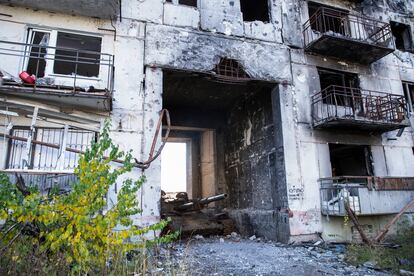
Severodonetsk is governed by an authority imposed from Russia. The mayor — Nikolai Morgunov — was a member of the pro-Russian Party of Regions, which was led by former Ukrainian President Viktor Yanukovych (2010-2014). In May 2014, Morgunov switched to the Russian separatist side. At the time, he was mayor of Brianka, a city where one of the most violent pro-Russian battalions — the Brianka USSR — engaged in fighting. Several of its members subsequently admitted that numerous tortures and murders were committed among the local population.
“The first members of the [Russian] administration joined in July of last year. The situation was terrifying. The city was 80% destroyed… There was no water, electricity, or gas,” says Morgunov at the city hall, where the marks of shrapnel and bullet holes are still visible. “There were also unburied corpses of civilians in the streets. In the courtyards, there were about 250 graves. People couldn’t bury their loved ones properly,” he sighs.
Morgunov emphasizes that the Ukrainian forces blocked the streets with destroyed cars and mined numerous buildings. They “tried to scare” the population into leaving the city, due to the imminent street fighting. According to his calculations, 92 out of every 100 inhabitants fled. However, he doesn’t want everyone to return.
“There are people who deliberately left Severodonetsk and headed to Ukraine. Will we wait for them? No. The people who live here today, who have returned, are the ones who have the right to build their future,” Morgunov warns. “Everyone had the opportunity to return, everyone had the opportunity not to abandon this land. Some were scared, some were convinced, some gave in.” Morgunov — who accuses the former Ukrainian mayor of having personally placed an anti-tank mine in his office — estimates that more than 1,000 civilians were killed during the fighting in the city.
2014, a cursed date
The eight years since the Donbas War have profoundly altered the political situation in the region: hundreds of thousands of pro-Ukrainian residents left their homes behind to go to Europe, or to the west of the country. On the other hand, a part of the population that remained has waited in legal limbo for Russia to annex their territory. They often blame the 2014 Maidan Uprising as the origin of the war, despite Ukraine’s previous frictions with Moscow (such as the 2009-210 gas crises, or the poisoning of pro-European Ukrainian leader Viktor Yushchenko in 2004).
The city of Luhansk — with about 430,000 inhabitants, according to the Russian authorities — is very far from the front. It could pass for a normal city, except for some small details, such as the gigantic loudspeakers of its anti-aircraft sirens. The regional capital bustles with life. Unlike in Severodonetsk, many children play in the parks.
For its inhabitants, a fateful date was June 2, 2014, when a Ukrainian Air Force plane bombed the central park, killing eight civilians. “It was difficult to understand that [the plane] didn’t have a Russian flag [painted on it], but a Ukrainian one. We consider that day to be the beginning of Ukraine’s war against peaceful Donbas,” explains Nikolai, 60, who owns a hunting weapons store with his wife, Tatiana, 52, who was hurt by a projectile in another Ukrainian strike.
The story is important on both sides of the war. Although this couple describes the separatist region in recent years as “a banana republic,” they emphasize that local militias “only” took over the local headquarters of the Security Service of Ukraine (SBU) in 2014, unlike during “the Maidan coup.” They point out that the irruption of the Russian military in Donbas in April 2015 — as well as the skirmishes and the battle for the Donetsk International Airport in May — were somewhat “distant” for them.
Few residents of the city recognize the face of a statue erected in the center of Luhansk, in tribute “to the volunteers.” The soldier — who is embraced by a statue of a little girl — is none other than Dmitry Utkin, the main commander of the Wagner mercenaries until his death this past summer. He was killed in an unexplained air disaster in August, alongside rebel Yevgeny Prigozhin.
Some of the soldiers today were children in 2014. Their childhood was marked by war. They have a lot of local support: Yevgenia is a Russian volunteer who weaves camouflage vests for the army, which she considers “humanitarian aid.”
“Every man must defend his homeland,” says Andréi, 22-years-old. A soldier since the age of 19, he enlisted under the self-proclaimed Luhansk People’s Republic. The fighter traces his decision back to July 26, 2014, when — during his grandfather’s birthday — the assault on the airport began. The family lived next door. “There were no soldiers in our town and they shot at the kindergarten. Why?” he wonders.
“Many people in Luhansk have forgotten about the [2014-2015] war,” he shrugs. “Everyone wants to live, everyone is afraid,” he says, an opinion shared by his 34-year-old comrade. “Ukraine hasn’t existed as such. Read the history. This was [all once] Kyivan Rus… history repeats itself,” the soldier adds. He is also called Andréi. He’s pessimistic about the future. “What will come next? Europe against us?”
The conversation with EL PAÍS is limited to learning about their motivations for fighting. Under Russian law, any dissemination of information that could reveal military secrets is punishable with jail time. They say that their work is limited to “surviving and following orders.”
Between Luhansk and Severodonetsk, there’s a haven of peace: Shchastia. In this small municipality, the fighting was brief. In the town square — where a crater is still visible — two women are walking with their children. “There’s no reason to choose between living in Russia or Ukraine. The main thing, for me, is that there’s silence, that my children don’t hear gunshots, bombings and all of that. Let my children study,” pleads Yulia, 34, a resident of Kramatorsk, a Ukrainian-controlled city in the Donetsk province. She’s waiting in Shchastia with her family until they’re able to return home.
“We haven’t unpacked… I want peace, I’m tired of this. This isn’t my home, we’ve left everything behind,” she adds. Both she and her friend Yelena — 37-years-old with three children — have Russian passports. “You have to feed your children, you have to live. With a Ukrainian passport, you can’t get a job anywhere,” Yulia affirms.
Residents of the Luhansk province often complain that they receive almost no humanitarian aid. “They promised us mountains of gold, but we receive 500 rubles (about $6) a month, can you believe it?” laments Oleg, amid the ruins of Severodonetsk. He dreams of getting a new pair of boots and a cell phone to regain contact with his acquaintances, including those on the Ukrainian side.
One of the points where humanitarian aid is delivered is to the Lesnaya Dacha shrine. Yevgeni has brought some resources there. “They need medicines and construction materials to cover the windows,” he explains, before stating that Russians like him “fight for our own, for our language.”
The church escaped the bombings unscathed, although some icons in its collection now have shrapnel holes. “There’s always a reason for war,” says Liubov Alekseyevna, 68, the former mother superior. She directly blames Ukraine for provoking the conflict.
“We always walk with God and we always win with God,” she states softly, while artillery explosions echo in the distance. Looking past the fences that protect the hermitage, you can see the forest of crosses rising. The nun notes that the cemetery is where hundreds of innocent “martyrs” from this war are buried.
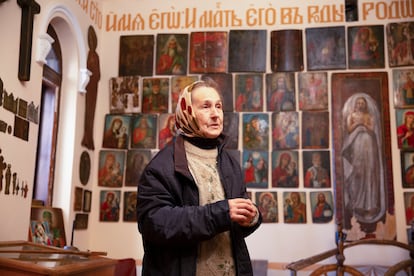
Sign up for our weekly newsletter to get more English-language news coverage from EL PAÍS USA Edition
Tu suscripción se está usando en otro dispositivo
¿Quieres añadir otro usuario a tu suscripción?
Si continúas leyendo en este dispositivo, no se podrá leer en el otro.
FlechaTu suscripción se está usando en otro dispositivo y solo puedes acceder a EL PAÍS desde un dispositivo a la vez.
Si quieres compartir tu cuenta, cambia tu suscripción a la modalidad Premium, así podrás añadir otro usuario. Cada uno accederá con su propia cuenta de email, lo que os permitirá personalizar vuestra experiencia en EL PAÍS.
¿Tienes una suscripción de empresa? Accede aquí para contratar más cuentas.
En el caso de no saber quién está usando tu cuenta, te recomendamos cambiar tu contraseña aquí.
Si decides continuar compartiendo tu cuenta, este mensaje se mostrará en tu dispositivo y en el de la otra persona que está usando tu cuenta de forma indefinida, afectando a tu experiencia de lectura. Puedes consultar aquí los términos y condiciones de la suscripción digital.
More information
Archived In
Últimas noticias
Kate Winslet makes her directorial debut: ‘There aren’t more female directors because we’re busy raising children’
ChatGPT fails the test: This is how it endangers the lives of minors
The late consecration of women artists in their 90s
The Florida Keys tourist paradise is besieged by immigration agents: ‘We’ve never seen anything like this’
Most viewed
- Families demand repatriation of bodies of Colombians who died in Ukraine: ‘This war is a slaughterhouse for foreigners’
- The low-cost creative revolution: How technology is making art accessible to everyone
- Liset Menéndez de la Prida, neuroscientist: ‘It’s not normal to constantly seek pleasure; it’s important to be bored, to be calm’
- Christian Louboutin: ‘Young people don’t want to be like their parents. And if their parents wear sneakers, they’re going to look for something else’
- ‘El Limones’ and the growing union disguise of Mexican organized crime
